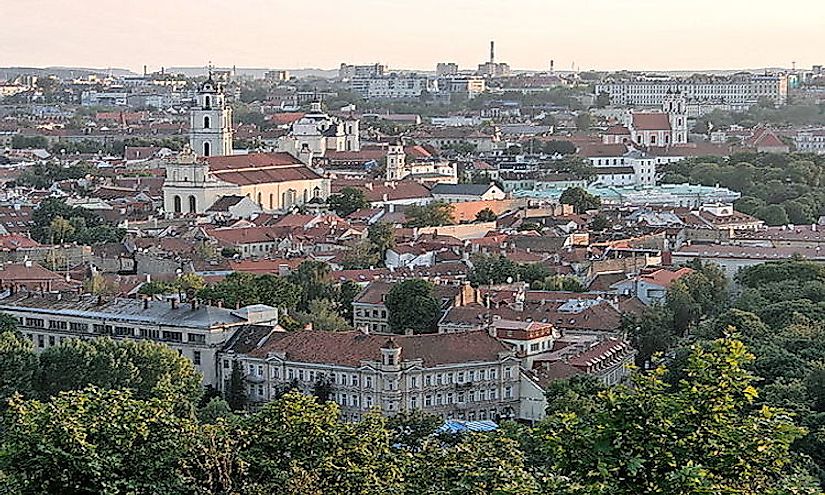UNESCO World Heritage Sites In Lithuania

Lithuania is a country located in Northern Europe and is the southernmost of the three Baltic states. Lithuania today has four United Nations Educational, Scientific and Cultural Organization (UNESCO) World Heritage Sites, with the first being designated in 1994 and the other three being designated between 2000 and 2005.
Lithuania's UNESCO World Heritage Sites
Curonian Spit
The Curonian Spit is located in the Kalipeda Region of Lithuania and the Kaliningrad Region of Russia. The Curonian Spit is an extended sand dune peninsula that is a total of 98 kilometers (60.89 miles) long and it separates the Curonian Lagoon with the Baltic Sea. The site was an important trading area for the pagan groups in the Baltic region before becoming a base for the Teutonic Knights, who built several castle near the area. Since the 19th century the area has turned into a resort location, with the eight current settlements on the site taking up about 6% of the land. Over the 17th and 18th centuries over logging at the site caused the dunes to start to bury settlements. Since the early 19th century the area has been worked on to try and stabilize the dune, with a protective dune ridge being added, along with the area being reinforced with trees and hedges.
Kernavė Archaeological Site and Cultural Reserve
The Kernavė Archaeological Site and Cultural Reserve is located in Vilnius County in the valley of the Neris River. The site contains evidence of human settlement from the late Paleolithic Period to the Middle Ages. The site has cultural layers, burial sites, hill forts, the ancient settlement of Kernavė, the Kernavė cemetery and other archaeological evidence ranging from between the 9th and 8th century BC to the late 14th century AD. The site is important today for archaeologists who are able to study how human settlements and live evolved and changing the Baltic region over thousands of years.
Struve Geodetic Arc Station Points
The Struve Geodetic Arc Station Points are located across Northern and Eastern Europe and are found in Norway, Sweden, Finland, Estonia, Latvia, Lithuania, Belarus, Ukraine, Moldova, and Russia. The Struve Geodetic Arc Station Points are a series of survey triangulations that were done between 1816 and 1855 from Norway to the Black Sea. This survey was undertaken by German astronomer Friedrich Georg Wilhelm Struve (1793-1864) and were the first accurate measuring ever done of a long segment of a meridian line. The original survey arc was made up of 258 main triangles with 265 main station points, although the site today only includes the 34 original station points. The site is important today for to show how the earth sciences, topographic mapping and scientific collaboration were all able to develop.
Vilnius Historic Center
The Vilnius Historic Center is in Vilnius County and is part of the capital city of Vilnius. Vilnius did not start to develop as a city until the 13th century under the Grand Duchy of Lithuania (1236-1795), eventually becoming its capital in 1323. From the end of the 13th century before becoming the capital, until the end of the Grand Duchy of Lithuania, Vilnius was the political center of the country and its architecture influence most of Eastern Europe. The Vilnius Historic Center is made up of the areas of three castles and has architecture from the Gothic, Renaissance, Baroque and other styles. Today the Vilnius Historic Center stands as an amazing example of a medieval foundation of a city and shows the rich diversity in building styles that took places across hundreds of years of European history.
The threats to Lithuania's UNESCO World Heritage Sites:
The major threats to the Curonian Spit are from erosion, ground and marine transport infrastructure, surface water pollution, threats from oil and gas and from a lack of a management plan for the site. The Kernavė Archaeological Site is very well preserved from decades of being left alone, but there is a concern that the rise of tourism to the region may affect the site authenticity. The Struve Geodetic Arc Station Points faces no major threats and are the points are in their original location, with only minor changes having been made. The Vilnius Historic Center has maintained its authenticity and integrity by being extremely well managed and with buildings been reconstructed following World War Two. The only threat that the site faces is from newer housing in the area that clashes with the site's history.
UNESCO World Heritage Sites In Lithuania
| UNESCO World Heritage Sites in Lithuania | Year of Inscription; Type |
| Curonian Spit | 2000; Cultural |
| Kernavė Archaeological Site and Cultural Reserve | 2004; Cultural |
| Struve Geodetic Arc Station Points | 2005; Cultural |
| Vilnius Historic Center | 1994; Cultural |







